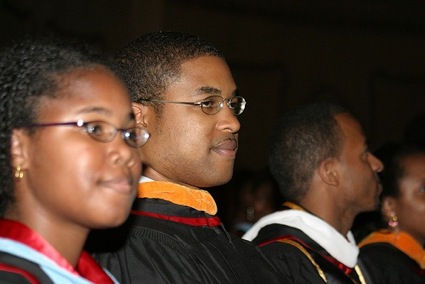Mo bronze high schools don't have achievement gap; they just don't serve minority populations

❝A successful high school should show high levels of student achievement, graduate almost all of its students and not let any demographic subgroup lag far behind.❞
Mathews counters that
❝such criteria automatically exclude virtually any school serving large numbers of poor or minority students.❞
I think he's onto something.
Rotherham seems to focus on the forest:
❝Remember that when Sara Mead and I took a look at the performance of the top 100 Challenge Index schools on their state assessments we found average black - white gaps in pass rates of 26 points in reading and 31 points in math. One school had a 61 point gap in math!❞

A high school like Alton made the U.S. News and World Report bronze star list with only 37% proficiency in math and 33.9% in reading. Sure their discrepancy numbers are only 3.5 in math and 9.8 in reading, but with only 7 African-American students in the high school (1.8%) and such low overall proficiency numbers, is it really a best school? It does have a high percentage of free/reduced lunch students, Missouri does have a tough test, and the school should be commended for the job it is doing, but that doesn't mean I would send my kids there. Maybe I would—I don't know because these numbers just don't provide enough information. (The number of AP courses offered is more relevant for me as a parent.)
While policy wonks and politicians debate the achievement gap, parents want their kids to go to the best high schools for their kids, which is the purpose of the rankings. The St. Louis Black Leadership Roundtable, a group working with the St. Louis area school districts to decrease the achievement gap, found that the best schools for African-American students were not the ones with the lowest achievement gaps.
❝A telling conclusion of the report was that schools with the highest achievement levels among black students - such as Clayton, Webster Groves and Kirkwood - often also had the greatest gap in achievement levels between whites and blacks.❞ (BLR 2005 Education Report Card, link to actual report card not operable)
Clayton has a reputation as one of the top public high schools in Missouri and has high (for Missouri) proficiency numbers (70.2 math, 63.8 reading) and relatively high numbers for black students (37.3 math, 22 reading). Again, wide discrepancy numbers (43.9 math, 55.7 reading). The district and others like it should be praised for choosing to continue in the voluntary transfer program instead of kept off of best high schools lists at the same time encouraged to improve black students' achievement. I prefer to focus on improving a subgroup's achievement over focusing on the achievement gap since lowering overall achievement decreases the gap.
The U.S. News & World Report eliminated any school in Missouri with an ethnic population (except Metro and Lincoln College Prep, which are selective). That is not the way to encourage student achievement for all.
(Mo. high school numbers from the Mo. DESE School Data and Statistics Database)
Zoooommmm!!!!! Changing our perspective

❝Our focus is not what works for policy makers but what is most useful for readers, particularly parents, trying to judge the quality of their local schools and others that might be available to them.❞

This dichotomy plays itself out issue after issue. As a mother I find myself looking at topics from a different viewpoint than as a teacher or someone interested in policy. We need a sliding scale to easily resize our perspective up and down, from individual child to classroom to school to whole system.
But, but, why isn't MYYYYY school on the Best Schools List?
The Newsweek list, compiled by Jay Mathews, uses the number of AP and IB exams a high school gives as its sole criteria. The idea is that students can improve their academics by taking AP courses. The idea is that any school can improve its rankings by encouraging more students to take the exams. While the list has its faults, the criterion is easy to understand. In St. Louis the better high schools are ranked higher, so it seems to make sense.
The new US News & World Report list though is different. The methodology is complex. A high school has to have its economically disadvantaged and minority populations outperform the state average on state tests. The focus here is on the achievement gap, which I will post on another time. If it passes this criteria, a college readiness score is given based on AP tests, both # given and average scores. High ranking schools are then slated into three categories: gold, silver and bronze.
While I appreciate the attempt to measure multiple factors and applaud overperforming schools, I have several concerns about this method of ranking:
☹Mixing of methods. Since the bronze high schools don't include college readiness scores, they should be treated as a separate ranking. When I looked up the state proficiency scores for the Missouri bronze scores, they were often fairly low. Most parents aren't going to read complicated methodology papers (pdf) demonstrating that these aren't actually the "best" but overperforming in some statistical manner.
☹Mismatch between audience and methodology. Jay Mathews explained this one well:
❝Our focus is not what works for policy makers but what is most useful for readers, particularly parents, trying to judge the quality of their local schools and others that might be available to them.❞
The overperforming schools list would be better given in Phi Delta Kappan than a general magazine.
☹Too many criteria. Yes, I know what is best is determined by what priorities someone has. That is why the Newsweek list works―people know what is being measured. If Andy Rotherham wants to focus on broader criteria, multiple lists would be more helpful for parents. I enjoyed clicking through the top magnet schools, top open enrollment etc.
☹Regional lists. If you don't live on the coasts or in other large states, you must not have any good schools―at least according to people who do these rankings. I don't know how the numbers work that way, but those of us in flyover country are used to being overlooked, but we have excellent college prep public high schools too.
In Missouri only Metro (St. Louis city's gifted magnet school) and Rock Bridge (suburban Columbia) made the silver list. No one disputes that these two are great high schools, and of course Metro has great numbers as it's selective, but I contend that some of the St. Louis county schools are as strong as Rock Bridge.
27 Missouri high schools are on the bronze list, but none of them are in St. Louis county. These are in the overperforming for their demographics but not necessarily strong schools category. I'll make a separate post with detailed numbers since this one is already long.
I think most parents would prefer a clearer, easier to understand list that actually gives usable information. Here's to modifications for next year!